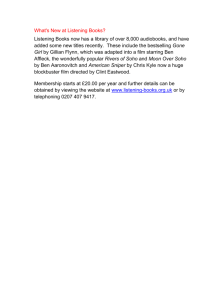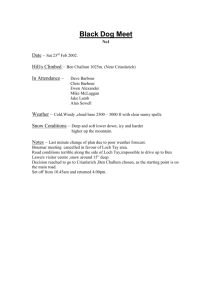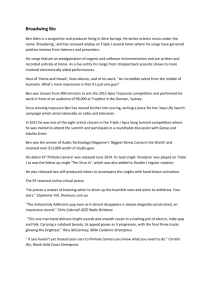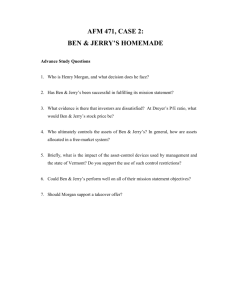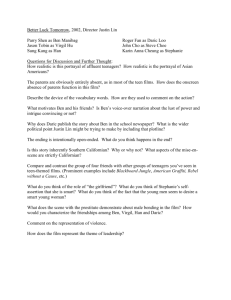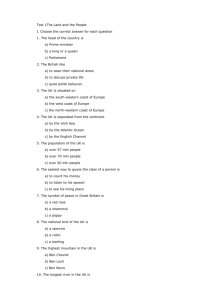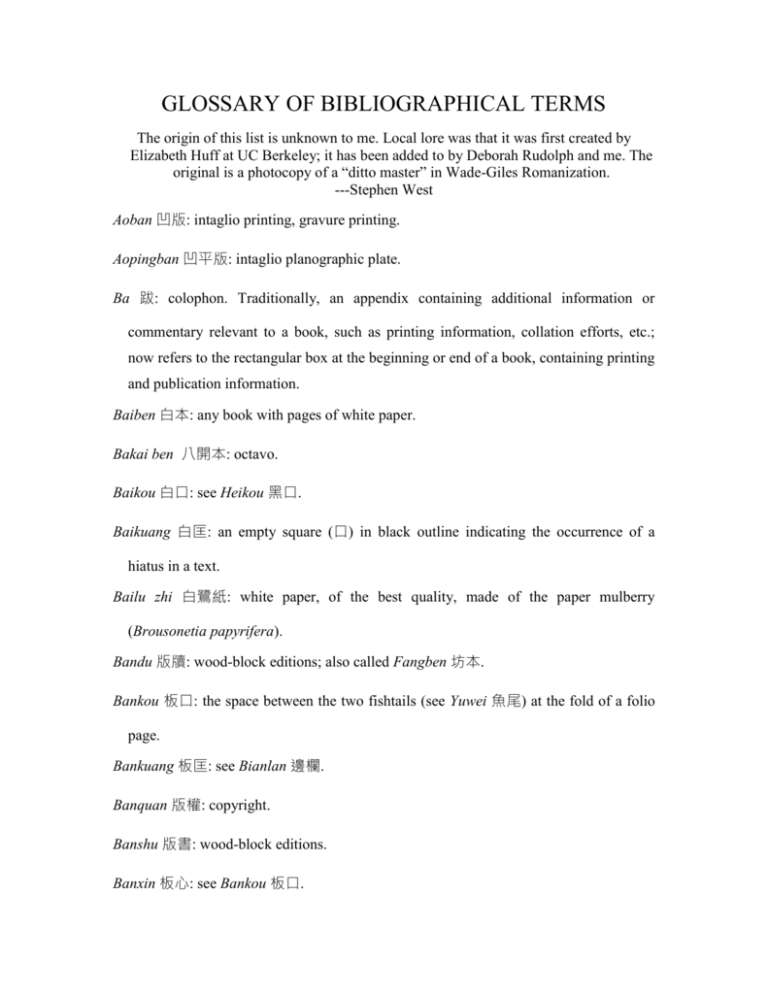
GLOSSARY OF BIBLIOGRAPHICAL TERMS
The origin of this list is unknown to me. Local lore was that it was first created by
Elizabeth Huff at UC Berkeley; it has been added to by Deborah Rudolph and me. The
original is a photocopy of a “ditto master” in Wade-Giles Romanization.
---Stephen West
Aoban 凹版: intaglio printing, gravure printing.
Aopingban 凹平版: intaglio planographic plate.
Ba 跋: colophon. Traditionally, an appendix containing additional information or
commentary relevant to a book, such as printing information, collation efforts, etc.;
now refers to the rectangular box at the beginning or end of a book, containing printing
and publication information.
Baiben 白本: any book with pages of white paper.
Bakai ben 八開本: octavo.
Baikou 白口: see Heikou 黑口.
Baikuang 白匡: an empty square (口) in black outline indicating the occurrence of a
hiatus in a text.
Bailu zhi 白鷺紙: white paper, of the best quality, made of the paper mulberry
(Brousonetia papyrifera).
Bandu 版牘: wood-block editions; also called Fangben 坊本.
Bankou 板口: the space between the two fishtails (see Yuwei 魚尾) at the fold of a folio
page.
Bankuang 板匡: see Bianlan 邊欄.
Banquan 版權: copyright.
Banshu 版書: wood-block editions.
Banxin 板心: see Bankou 板口.
Banxing 板行 : see Qianmu 嵌木.
Banye 半頁: a page, i.e., one side of a folio.
Bangzhi 磅紙: bond paper (transliteration).
Baobei zhuang 包背裝: “wrapped back binding”: a stiff-covered style of binding in
which the folded edges of the folios are at the “mouth” and the edges opposite the folds
are pasted into the spine; see SCC, p. fig. (f).
Baojiao 包角: reinforced corner.
Baozhi 報紙: newsprint.
Beiji 背記: commentaries written on the back of a book-scroll. (T)
Beijian ben 北監本: see Jianben 監本 .
Bian 編: a part, fascicle, section, series; e.g., neibian 內編/waibian 外編, qianbian
前編/houbian 後編, etc.
Bianlan 邊欄: the margin (horizontal and vertical) of a printed page; see SCC, p. fig. (d).
Bianyan 弁言: foreword.
Bianzhun 邊準: columns (a Tang term).
Biao裱: protective end on a scroll, serving as an outside cover.
Biaodian 標點: to add punctuation marks by the lines of a text.
Biaoji 標記: marginal notes; exegeses of words or sentences written in the top or bottom
margin or between columns.
Boli ban 玻璃版: collotype.
Bona ben 百衲本: an edition made up of sections taken from various editions.
Boshu 帛書: a book made of silk.
Buyi 補遺: addendum.
Buzhu zhuanren xingshi 不著撰人姓氏: see Shiming 失名.
Caise shiben 彩色石本: lithochromography.
Caise yinshua 彩色印刷: color printing.
Canben 殘本: an imperfect copy; an incomplete edition.
Canjian zhi 蠶繭紙: paper made of silk-cocoon fibers.
Ce 冊: 1) bamboo strips; 2) a volume.
Chang Song 長宋: a kind of type face.
Chanmu 鑱木 : wood engraving.
Chanyi ta 蟬翼搨: a rubbing made on paper that is thin and translucent.
Chanyi tuo 蟬翼拓: see Chanyi ta 蟬翼搨; see also Wujin ta 烏金搨.
Chaoben 抄本: a manuscript, or a manuscript copy; may be copied from another
manuscript or from a printed copy; also Xieben 寫本.
Chaobu ben 抄補本: see chaopei ben 抄配本.
Chaojiao ben 抄校本: a collated manuscript.
Chaopei ben 抄配本: a printed book with any missing parts supplied in manuscript; also
called chaobu ben 抄補本.
Chatu 插圖: illustrations.
Chaye 插頁: pages inserted into a text (but not paginated with the rest of the text),
containing illustrations, graphs, etc. Note: 頁 is used sometimes to indicate a full
Chinese page (i.e., a leaf) and sometimes to indicate a half Chinese page (i.e., one side
of a [folded] leaf); thus, it is not always clear how many actual inserts there are when a
插頁 notation is given.
Chengxin tang 澄心堂: see Sangpi zhi 桑皮紙.
Chengyinzhe 承印者: printer—appears in modern books as prefix to the name of the
printing company.
Chenye 襯頁: a flyleaf; extra pages (blank) inserted at the beginning or end of a book;
sometimes Chenzhi.
Chenzhi 襯紙: see Chenzhuang 襯裝.
Chenzhuang 襯裝: to interleaf (or interleaving); to remount (or the remounting of) the
folios of an old book on new paper inserted between the two pages of the folded leaf.
Chizhuan ben 敕撰本: books compiled by order of the emperor; also called Fengchi
zhuan 奉敕撰.
Chongkan ben 重刊本: a block-printed edition that is not the original edition; cf.
Yuankan ben 原刊本.
Chongyi ben 重譯本: retranslated edition.
Chongyin 重印: reprint.
Chouhui shu 抽燬書: books, parts of which have been destroyed in literary purgation.
Chouyin ben 抽印本: parts and sections of a book printed separately; offprint.
Chuanlian zhi 川連紙: paper made of bamboo fibers.
Chuban 出版: to publish.
Chunhua 春畫: "spring pictures" (erotic illustrations) included in books for the ostensible
purpose of keeping away silverfish.
Chuta 初拓: first rubbing; cf. Houta 後拓, later rubbing. Note: earlier rubbings are
clearer than later rubbings.
Chuyan 除言: to delete glosses that have been incorporated into a text; to correct a
corrupt text.
Chuyin 初印 : first or early impression.
Congshu ben 叢書本: an edition that is printed as part of a Congshu 叢書; cf. Danxing
ben單行本.
Cuojian 錯簡: disordered bamboo strips; and from this, corrupted texts.
Daben 打本: books of rubbings; the paper is tamped and patted in the process of making
a rubbing, hence the use of the term Da 打, "to beat."
Dahei kou 大黑口: a heavy line inside the elephant’s trunk (Xiangbi 象鼻).
Dajizhe 打幾折: how much discount?
Dan yuwei 單魚尾: a single fishtail; see Yuwei 魚尾.
Danbian 單邊: a broad, heavy line separating margin and text.
Danlan 單欄: see Lan 欄.
Danxing ben 單行本: a separately published edition (as opposed to an edition that is
printed as part of a Congshu 叢書).
Daolin zhi 道林紙: a white paper of fairly good quality, one of the best used for modern
Chinese editions; so-called because it was originally supplied by the Dowling
Company.
Daozang ben 道藏本: a book in the Taoist canon.
Dati 大題: running head; the title of a book.
Dawu zhe 打五折: to sell at 50% of full price.
Daxing ben 大形本: large paper edition (over 11”).
Daxu ben 大徐本: an edition of the Shuowen jiezi 說文解字 emended by Xu Xuan
(徐鉉) of the Southern Tang; cf. Xiaoxu ben 小徐本.
Dazhe kou 打折扣: to give a discount.
Dazi ben 大字本: large-type edition, with ten lines of text per page, and ten-some
characters per line; popular in Song and Yuan times.
Dengzi 等子: see Modeng 墨等.
Dianban 電版: electrotype.
Dianben 殿本: books published under the auspices of the Qianlong 乾隆 emperor (r.
1735 – 1796) of the Qing
dynasty; especially good editions, usually considered to be “rare books” (Shanben 善本).
Also called Wuying dianben 武英殿本.
Diaoban 雕版: wood-block printing.
Diaozao 雕造: wood engraving; to cut a wood block in preparation for printing.
Dijiao 地腳: the bottom horizontal margin of a page; see SCC, p. fig. (f).
Dingdai 頂帶: headband; a narrow strip of cloth sewn or glued by hand to a book at the
extreme ends of the backbone.
Dingjia 定價: list price, publisher’s price.
Dingwu ben 定武本: a rubbing of the "Dingwu" engraving of Wang Xizhi’s 王羲之 (321
– 379 or 303 – 361)
“Lanting xu” 蘭亭序, based on a freehand copy by Ouyang Xiu 歐陽修 (1007 – 1072),
in the style of Wang Xizhi. After the Tang engraving, which had disappeared between
the Five Dynasties and the early Song, resurfaced in the s, it was housed in the
government offices of Dingwu 定武, before being transferred to the Xuanhe dian
宣和殿 of the imperial palace in Kaifeng. The stone was lost forever with the fall of
Northern Song. The engraving was considered the best of the many copies of Wang
Xizhi’s original calligraphy (not extant).
Dingxian 訂線: stitching.
Dingxian 頂線: top line.
Dingzheng ben 訂正本: revised edition, corrected edition.
Dixiu ben 遞修本: a book that has undergone much repair; e.g., a book printed from
worn-out blocks, or one that has suffered through some natural disaster as a flood, fire,
etc.
Dizhuang 遞裝: a backing sheet used in book repair, generally glued to the back of a
deteriorating page to reinforce it.
Duben 讀本: a well-got-up edition.
Dujiao ben 度校本: an edition that includes both earlier and contemporary emendations
of the text.
Duli ben 獨立本: two volumes bound together, retaining their own covers and
pagination.
Erti 耳題: a thumb index—characters written on the outer margin of the page of a book,
giving the page number, title of the section, etc.; running heads.
Erzi 耳子: see Shuer 書耳.
Fanban 翻版: a reprint; also, a pirated edition.
Fanfu ben 藩府本: editions published under the patronage of princes and marquises.
Fangban 方版: a block of wood, used for making a printing block; wood-block edition.
Fangben 坊本: an ordinary edition.
Fanggu huozi 坊古活字: the name of a particular typeface.
Fangke ben 坊刻本: "bookshop edition," published by a bookshop.
Fangsong 仿宋: the name of a particular typeface, cut in imitation of Song-style script.
Fangtou heiti 方頭黑體: the name of a particular typeface.
Fanjia ben 梵夾本: "sutra binding"; see Jingzhe zhuang 經折裝.
Fanke ben 翻刻本: reprinted editions; re-engraved in original format; also called Fukan
ben復刊本, Moke ben摹刻本.
Fanke bijiu 翻刻必究: "All rights reserved" (lit., "If you make a reprint, you will
certainly be traced down").
Fanzhi 幡紙: a type of silk used in bookmaking.
Faxing 發行 : to publish; to "bring out" or distribute.
Fengchi zhuan奉敕撰: see Chizhuan ben 敕撰本.
Fengdi 封底: back cover of a book.
Fengmian 封面: front cover of a book.
Fenji 墳籍: classics and histories.
Fuben 複本: a second or duplicate copy, identical to the first in content, printing, date of
publication, but not in paper or binding.
Fukan ben 復刊本: see Fanke ben 翻刻本.
Fuke ben 附刻本: the second of two distinct and not necessarily related books published
in the same volume.
Fushi zhi 夫士紙: foolscap (transliteration).
Fushu ban 扶書版: bookend.
Fusong ben 復宋本: reprint of a Sung edition.
Fuye 副葉: flyleaf; also called Huye 護葉.
Fuyuan ben 復元本: reprint of a Yuan edition.
Gaiding 改訂: see Xiuding 修訂.
Gaizuo ben 改作本: adapted edition.
Gaoben 稿本: author’s draft manuscript; autograph draft; also called Shouchao ben
手抄本, Shouxie aoben手寫稿本, Shougao ben 手稿本.
Gaoli ben 高麗本: a wood-block edition printed in Korea; also Heben 和本.
Gaoli zhi 高麗紙: a fine white paper made in Korea.
Gaolu zhi 高鹿紙 : a strong, thick, white paper.
Gongdu zhi 公牘紙: paper used for public documents during the Sung dynasty, the back
of which was used for printing books. (T)
Gongku ben 公庫本: a wood-block edition of the Liji 禮記 published in the Sung
dynasty under the patronage
of the general administrator of Zhejiang—a very
carefully edited recension.
Gongyu 貢餘: tribute from Youhang, where Tengzhi 藤紙 (q.v.) was made.
Guanban 官版: official edition.
Guanke ben 官刻本: official editions (generated at various levels of administration).
Guben 孤本: the single existing copy of a book.
Guojiao ben 過校本: see Dujiao ben 度校本.
Haishi 亥豕: characters printed by mistake, as for 亥 for 刻 .
Hanfen lou 涵芬樓: name of the rare-book library of the Commercial Press.
Hanglian zhi 杭連紙: paper from Hangchow of bleached bamboo pulp, white in color;
also called Lianshi zhi 連史紙 , Liansi zhi 連絲紙.
Hanhe 函盒: a book wrapper in the traditional Chinese style; also called Hushu 護書,
Tao 套.
Heben 和本: see Gaoliben 高麗本.
Heding 合釘: separate volumes bound together.
Heidi baizi 黑地白字: see Yinwen 印文.
Heikou 黑口: the space at each end of the center strip of a folio page used to mark the
center for folding.
Heikou ben 黑口本: books printed in the format described in no.
Heipai 黑牌: the black line in the space between the “fishtail” (Yuwei 魚尾) and the
margin that makes that space a Heikou 黑口; without this strip, the space is called a
Paikou 牌口.
Heiti 黑體: the name of a particular typeface.
Hongben 紅本: a Qing edition containing commentaries written in red, issued by the
Hanlin Academy.
Houta 後拓: see Chuta 初拓.
Huakou 花口: the space between the two "fishtails" (yuwei 魚尾) in the center strip of a
folio page, when this space contains characters.
Huapei zhi 花胚紙: a superior grade of a paper used for copying, second only to the fine-
grained silk-cocoon paper of Japan and Korea.
Hudie zhuang 蝴蝶裝: "butterfly binding": a book whose folio leaves are folded down
the center and bound by pasting a stiff paper cover against the spine (of folded
centers); see SCC, p. fig. (e).
Huizhu 會注: see jizhu 集注.
Huozi 活字: movable type; usually applied to type made of some material other than
lead, such as wooden movable type.
Huozi ban 活字版: typography
Hushu 護書: see Hanhe 函盒.
Huye 護葉: see Fuye 副葉 .
Ji 集: see bian 編.
Jiaban 夾板: book boards, loose wooden covers for one or more volumes.
Jiake ben 家刻本: a wood-block edition cut by the writer’s family.
Jianben 建本: books published in Jianning and Jianyang in Fujian during Song and Yuan
times.
Jianben 監本: books published by the Directorate of Education (Guozi jian 國子監) in
Song and Ming times; see also Beijian ben 北監本, Nanjian ben 南監本.
Jiance 簡策: books written on bamboo slips.
Jiandiao 監雕: a term indicating official publication.
Jianshu ming 簡署名: half title, fly title; title printed on the page preceding the title
page.
Jiaoban zhi 膠版紙: cheap white paper like that used for Western-style books published
in the People’s Republic.
Jiaobei zhuang 角背裝: three-quarter binding (leather).
Jiaoben 校本: a revised edition.
Jiaochou 校讎: to collate the text; textual criticism; see also jiaokan 校勘.
Jiaoding ben 校訂本/校定本: a corrected text.
Jiaoji 校記: collation.
Jiaoji 校輯: collation and editing.
Jiaokan 校勘: 1) to collate a text; 2) a term indicating official publication.
Jiaokan 校刊: the action of cutting a wood block; by extension, to publish in a woodblock edition.
Jiaokan ji 校勘記: collation notes.
Jiaoke 校刻: see Jiaokan 校刊.
Jiaowei ben 焦尾本: a book that consists of the remnant part of a book damaged by fire.
Jiaozheng 校正: a term for private publication.
Jiaozheng ben 校正本: expurgated edition.
Jiaozhu 校注/註: footnote.
Jiashu ben 家塾本: private family edition, see also Shu shuben 蜀塾本.
Jie 界: vertical lines separating columns of text on a page.
Jiebei 揭背: see Dizhuang 遞裝.
Jiehang 解行: column, vertical lines of text on a page; Jie 界 (Song term).
Jielüe ben 節略本: abridged edition; also called Jieben 節本.
Jiezi 解字: Chinese movable type size (no. 5).
Jigu geben 汲古閣本: a copy once in the collection of Mao Jin 毛晉 (1599–1659); see
ECCP :–
Jijia 基價: base price.
Jijie 集解: see jizhu 集注.
Jincheng ben 進呈本: books presented to the emperor for his use.
Jingchang ben 經廠本: works published by the Directorate of Ceremony (Sili jian
司禮監) of the northern capital during the Ming dynasty.
Jingchao ben 精抄本: a fine or carefully executed manuscript copy.
Jingke ben 精刻本: a bound book; a high-quality edition.
Jingshi tushuguan zang ben 京師圖書館藏本: a book once in the collection of the
Imperial Library in Beijing.
Jingyuan zhi 京院紙: a soft, cottony paper sold in Canton.
Jingzhe zhuang 經摺裝: "sutra binding": a book in which a continuous length of paper
(probably consisting of several joined sheets) is folded into accordion-like pleats.
Jingzhuang 精裝: hard-cover books.
Jinshu 禁書: banned books (a Qing term).
Jinxiang ben 巾箱本: a small "pocket edition"; in particular, a Southern Sung bijou
edition; also called Xiuzhen ben 袖珍本.
Jiuchao ben 舊抄本: an old manuscript of unknown date.
Jiukan ben 舊刊本: a wood-cut edition of unspecified date.
Jiuke ben 舊刻本: a wood-cut edition of unspecific date.
Jiuti 舊題: old attribution (i.e., of doubtful authenticity).
Jiuxie ben 舊寫本: a manuscript edition of unspecified date.
Jiyi 輯佚: to reconstruct lost works.
Jizhu 集注: a collection of commentaries (commentaries on a certain text and
commentaries on commentaries); also jijie 集解 and huizhu 會注.
Juan 卷: a chapter in a traditional Chinese book; originally applied to scrolls.
Juan 絹: a thin, gauzy silk used in bookmaking.
Juanshu 絹書: books printed on fine white silk; see Su 素.
Juanzi ben 卷子本: a scroll that unrolls horizontally.
Juben 局本: official provincial edition.
Jueban 絕版: out of print.
Jueban shu 絕版書: out-of-print books.
Juzhen ban 聚珍版: Qing editions printed with movable type made of jujube wood.
Juzhen fang songzi 聚珍仿宋字: the name of a particular typeface, cut in wood and
carved in imitation of Song-style characters.
Kaiban 開版: the action of cutting a wood block (for printing).
Kaidiao 開雕: see Kaiban 開版.
Kaihua ben 開花本: a white paper of the highest quality selected for use in the Chユing
palace editions, made in Kaihua, Zhejiang.
Kaizao 開造: see Kaiban 開版.
Kan 刊: see Kaiban 開版; also, to publish.
Kanxing 刊行: to publish.
Kanxiu ben 刊修本: a book with any missing parts supplied (in print).
Keban 刻版: see Qianmu 嵌木.
Keban 殼版: cover board or cover.
Kebei 殼: spine (of a book).
Keluo ban 珂羅版: collotype.
Kemu 刻木: see Qianmu 嵌木.
Kezhi 刻紙: see Qianmu 嵌木.
Kouti 口題: characters (headings) printed in the space between the two "fishtails" (yuwei
魚尾) in the center strip of a folio page.
Kuanmu 款目: entry.
Lan 闌: the lines on a page that surround the text. A pair of parallel lines is called
Shuanglan 雙闌 ; a single line is called Danlan 單闌. See SCC, p. fig. (d).
Lanban 斕版: editions whose characters are illegible because of the poor condition of the
wood blocks.
Lange chaoben 藍格抄本: a manuscript with blue lines separating the columns of
characters.
Lanta 藍拓: see Zhuta 朱拓.
Lanwai ti 欄外題: a small square at the left or right bottom of a page, containing notes or
information of various kinds.
Lao Songti 老宋體: a “Song-style” typeface.
Lata ben 邋遢本: a poorly printed work; a corrupt edition.
Lianjia 廉價 : bargain price, "sale" price.
Lianshi zhi 連史紙: see Hanglian zhi 杭連紙.
Liansi zhi 連四紙: see Hanglian zhi 杭連紙.
Louban 鏤版: see Qianmu 嵌木.
Lujiao ben 錄校本: see Dujiao ben度校本.
Luzheng 錄正: private publications (as opposed to official ones).
Manhan hebi 滿漢合璧: a bilingual text, in Manchu and Chinese. (T)
Maobian 毛邊: deckle edge.
Maobian zhi 毛邊紙: is a heavy cream-colored paper with rough edges.
Maogao ben 毛稿本: manuscript edition.
Maotai 毛太: a rough-edged paper produced in Kiangsi province, thinner than Maobian
zhi 毛邊紙.
Maotou zhi 毛頭紙: flax paper with rough edges.
Maozhuang ben 毛裝本: deckle-edged edition; stitch-bound edition with uncut edges.
Masha ben 麻沙本: books published by the Mashazhen shufang 麻沙鎮書房, in
Jianyang, Fujian; also called Minben閔本—notoriously bad editions, printed from
blocks of soft wood.
Mazhi 麻紙: paper made of hemp fibers.
Meibiao 眉標: headnotes; equivalent to shumei 書眉.
Meiduan 眉端: top margin of a page.
Meipi 眉批: critical notes printed (or written) in the upper margin of a book page.
Mianzhi 棉紙: thin, cheap paper light yellow in color.
Mihang xiaozi ben 密行小子本: compact Song editions featuring close columns and
small print.
Minben 閩本: see Masha ben 麻沙本.
Mingzi 明字: Chinese movable type size (no. 2).
Moben 墨本: a book printed in black ink.
Moben 摹本: see Moxie ben 摹寫本.
Modeng 墨等: a black square (█ █) indicating the occurrence of a hiatus in a text; also
called 等字 , Moding 釘.
Moding 墨釘: see Modeng 墨等.
Mogai zi 墨蓋子: characters printed in intaglio (so that the characters show up white on a
dark background).
Moke 摹刻: see Qianmu 嵌木 .
Moke ben 摹刻本: see Fanke ben 翻刻本.
Motuo 摹拓: see Zhutuo .
Mowei 摹圍: a small cartouche within a text, containing subheadings or commentary.
Moxie ben 摹寫本: a traced copy. (T)
Muji 木記: a rectangular, oval, or ya 亞–shaped figure occurring after a preface, table of
contents, or chapter, marking the end; also called paiji 牌記and tuji 圖記.
Mukan 木刊: to print by subscription.
Muke ban 木刻板: a wood-block edition.
Mulu 目錄: table of contents; also called Muci 目次.
Nanjian ben 南監本: an edition published by the Directorate of Education (Guozi jian
國子監 ) at Nanjing.
Neifu kanben 內府刊本: a Qing palace edition.
Paiji 牌記: see Muji 木記 .
Paiyin ben 排印本: typeset edition.
Peiben 配本: a book put together by taking sections from various editions; also called
Peibu ben 配補本.
Pian 篇: a section; a pamphlet.
Pianmian tou 片面頭: broadside, broadside sheet.
Pidian ben 批點本: editions that have undergone revision or been manipulated or
tampered with.
Pijiao 枇校: collation with critical notes.
Pingban 平版: planographic printing (a process of printing from a flat or plate surface,
such as stone, zinc, or aluminum, employed in lithography or offset printing).
Pingben 評本: editions that include critical notes and punctuation marks.
Pingzhuang 平裝: ordinary (usually paperback) edition.
Puji ben 普及本: a cheap edition.
Qian 籖: tags attached to the end of book scrolls, bearing the title of the book and other
information, as number of juan, etc.
Qianban 嵌板: see Qianmu 嵌木 .
Qianban 鉛版: stereotypography.
Qianben 槧本: wood-block edition.
Qianben 鈐本: a book with impressions of collectors’ seals.
Qianmu 嵌木 : the action of cutting a wood block (for a book); by extension, to publish a
wood-block edition. Note: there are at least 6 terms that are used for this sort of wood
cutting.
Qianyinben 鉛印本: typeset edition (printed from lead movable type).
Qie 篋: portfolio.
Qin ding 欽定: works authorized by imperial order or sponsored under imperial auspices.
Qin mu 鋟木: the action of wood-cutting, hence to cut a block for printing a book. By
extension, to publish a woodblock edition.
Qin zi 鋟梓: see Qin mu 鋟木 .
Qing Han hebi ben 清漢合璧本: a bingual edition, with Chinese text on the left and
Manchu on the right, also known as Man Han hebi ben 滿漢合璧本.
Qishu 漆書: bamboo slips with characters written in lacquer.
Queming闋名: see Shiming 失名.
Rangu 染古: see Zhuanghuang 裝潢.
Ranhuang 染潢: see Zhuanghuang 裝潢.
Renke ban 認可版: authorized edition.
Ruanji 軟徛: flexible back (of a book).
Sanchao ben 三朝本: a Southern Song wood-block edition, printed under government
sponsorship, that survived the Yuan, during which it was emended slightly, and the
Ming, during which it passed into the collection of the Directorate of Education (Guozi
jian 國子監 ) at Nanjing.
Sangpi zhi 桑皮紙: paper made of mulberry bark; the most celebrated mulberry-bark
paper was Chengxin Tangzhi 澄心堂紙, made for the last ruler of the Southern Tang,
Li Yu 李煜.
Sanhe ben 三合本: a trilingual text, in Manchu, Mongolian, and Chinese.
Sanse ben 三色本: a book printed in three colors.
Santi shijing 三體石經: see Shijing 石經.
Sanye 散頁: a loose leaf.
Shanben 善本: ) rare books; ) carefully emended editions.
Shengzhi 生紙: undyed, raw paper.
Shihang ben 十行本: a book with ten columns to the page.
Shijing 石經: stone engravings of the Confucian classics, carved between the second and
the eighteenth centuries. According to the Houhan shu 後漢書, the text of the
engravings undertaken during the reign of Ling Di 靈帝(r. 168 – 189), also known as
the Xiping stone classics 熹平石經, employed three script styles (Santi 三體 ), by
imperial command: ancient style (Guwen 古文 ), seal style (Zhuanshu 篆書), and
clerical style (Lishu 隸書). (Note that recent archaeological findings do not bear out
this description.)
Shili juben 士禮居本: a book once in the collection of the bibliophile Huang Pilie
黃丕烈; see ECCP :–
Shiming 失名: author’s name unknown, anonymous. Other terms used for "anon."
include Queming 闕名, Buzhu zhuanren xingshi 不著撰人姓氏 , and Wuming shi
無名氏.
Shixing 施行: to publish.
Shiyin ben 石印本: a lithographed edition.
Shiyu 詩語: marginalia; brief comments written in the margins of a book by a reader. A
copy of a book or a manuscript containing marginalia by a noted scholar or bibliophile
would naturally be of greater academic, not to mention aesthetic or sentimental,
interest than a copy without.
Shizang ben 釋藏本: a book in the Buddhist canon.
Shouchao ben 手抄本: an autograph copy, an author’s handwritten manuscript.
Shougao ben 手稿本
Shouxie gaoben 手寫稿本: an autograph draft.
Shu dazi ben 蜀大字本: editions published in Sichuan during the Song dynasty featuring
large characters and few columns.
Shu shuben 蜀塾本: books issued by private family schools during the Song dynasty.
Shuangbian 雙邊: the outer margin enclosing text on a page and the fine line, just inside
the margin, running parallel to it.
Shuanglan 雙闌: see Lan 闌.
Shuang yuwei 雙魚尾: double fishtail; see Yuwei 魚尾.
Shubei 書背: the spine of a book.
Shuben 蜀本: books published in Sichuan during Song times.
Shuer 書耳: a narrow vertical box at either the top right or top left margin of a page,
outside the margin (bianlan 邊欄); usually found in Song and Yuan editions. See SCC,
p. fig. (g).
Shuge 書格: see Shuer 書耳.
Shugen 書根: the bottom edge of a book.
Shukou 書口: the edge opposite the spine of the book, the fore edge.
Shukuan 樞款: joints, hinges.
Shumei 書眉: the blank space between the margin (Bianlan 邊欄) and the top of the
page; also called Tiantou
天頭. See SCC, p. fig. (e).
Shuming ye 書名頁: title page.
Shunao 書腦: the spine of a book (cf. Shubei 書背) the black margin in the gutter of a
book, nearest the stitching.
Shupa ben 書帕本: an edition published by a local official during Ming times,
customarily wrapped in a kerchief for presentation to a superior. These are notoriously
bad editions.
Shupeng ben 書棚本: books published by the Chen- and Yin-family bookstores in Linan
during the Sung dynasty.
Shupi 書皮: book cover.
Shupin 書品: the quality of the paper and binding of a book, the size of its text, its age,
etc.
Shushou 書首: the top edge of a book.
Shutao 書套: the separate protective cover enclosing a single fascicle or a set of fascicles
of a traditionally bound Chinese book.
Shuyi 書衣: book cover (front or back). Also called Shukou 書口.
Shuyuan ben 書院本: editions published by the academies.
Shuzhi 熟紙: prepared paper, dyed paper.
Sibian 絲編: the silk cord fastening bamboo strips or wooden tablets together so that they
might be rolled or folded against one another accordion-style.
Sikai ben 四開本: quarto
Songban shu 宋版書: Song dynasty wood-block editions.
Songti zi 宋體字 : a kind of typeface, with characters square and somewhat rigid in
appearance; cf. Yuanti zi 元體字.
Su 素: plain white silk, undyed and without design; cf. Qian, a fine silk, closely woven of
double threads and yellowish in color.
Suoge 縮格: indentation.
Taben 搨本: a rubbing.
Tangjuan ziben 唐卷子本: a Japanese reprint of a Tang manuscript roll.
Tao 套: see Shutao 書套.
Taose 套色: to produce a multicolor edition.
Taoyin 套印: a multicolor edition.
Tejia 特價: a special price (usually a discount).
Tengxie ban 謄寫版: mimeography.
Tengzhi 藤紙: paper made of the climbing rattan (Calmus rotan).
Tianbian 天邊: top edge.
Tianjin bian 天金編: gilt.
Tiantou 天頭: see Shumei書眉.
Tianyi geben天一閣本: a book once in the Tianyi ge, the private book collection of the
Fan family of Ningbo; see ECCP :
Tici 題辭: epigraph.
Tiyao提要: résumé.
Tongban 銅版: copper-plate printing.
Tongban huozi 仝板活字: copper movable type (仝 is used here as an abbreviation for
銅; see HJAS [–]: ).
Tongxing ben 通行本: an ordinary edition.
Tuban 凸版: relief printing (plate), letter-press printing.
Tuji 圖記: a device in the shape of a bell, cauldron (Ding鼎), jue角, or ge 鬲, following a
preface, table of contents, or chapter end; cf. Muji 木記and Paiji 牌記.
Tuoben 拓本: see Taben 拓本.
Wagai ben 挖改本: editions emended by literati; so-called because a knife was used to
cut out incorrect characters, and the empty spaces filled with bamboo paper.
Wan 紈: Gossamer white textile of raw silk.
Weibian 韋編: leather binding.
Weizhuang ben 未裝本: an unbound book.
Wenyuan geben 文淵閣本: an edition based on an item in the Wenyuan ge collection (the
Wenyuan ge was where the Siku quanshu 四庫全書 was stored in the Forbidden City
of Beijing).
Wujin ta 烏金搨: a rubbing made on Xuanzhi 宣紙, using very black ink.
Wujin zhi 烏金紙: a glossy paper with gold flecks on a black ground.
Wuming shi無名氏: see Shiming 失名.
Wuse ben 五色本: 1) multicolor editions produced during the Sung dynasty (largely
colored botanical illustrations); 2) books with different commentaries printed in
different colors.
Wusi lan烏絲欄: the narrow black ruling separating columns of characters on a page.
Wuyingdian ben 武英殿本: see Dianben 殿本. (The Wuying dian, or “Hall of Military
Glory,” housed the Qing Imperial Printing Office [Xiushu chu 修書處.)
Wuyingdian juzhenben congshu 武英殿聚珍版叢書: a Congshu of titles printed from
wooden movable type during the Qianlong era (1735 – 1796).
Xiangben 象鼻 : “elephant’s trunk,” a light or heavy line used to mark the center of a
folio page for folding, extending from the “fishtail” (Yuwei魚尾) to the upper and/or
lower margin of the block; see SCC, p. fig. (a).
Xiangpi ban 橡皮版: offset printing.
Xianzhuang shu 線裝本: a stitch-bound book; a book bound in the traditional Chinese
manner.
Xiaohei kou 小黑口: a fine black line at each end of the center strip of a folio page used
to mark the center for folding; see Heikou 黑口; cf. Dahei kou 大黑口
Xiaoshu ben 小徐本: an edition of the Shuowen jiezi 說文解字 emended by Xu Kai 徐鍇
of the Southern Tang; cf. Daxu ben 大徐本.
Xiaoti 小題: running head for a small division in a book (such as a paragraph);
subheading.
Xiaozi ben 小字本: a small-type edition; cf. Dazi ben 大字本.
Xieben 寫本: see Chaoben鈔本.
Xiekan ben 寫刊本: printed edition with script style modeled after that of a celebrated
calligrapher.
Xinban 鋅版: zincograph.
Xindiao 新雕: see Qianmu嵌木.
Xinkan 新刊: see Qianmu 嵌木.Xianzi 顯字: Chinese movable type size (no. 1, the
largest).
Xiu 修: to sponsor the compilation of gazetteers or dynastic histories.
Xiubu ben 修補本: see Dixiu ben.
Xiuding 修訂: to revise; also called Gaiding 改訂.
Xiuzhe 修者: compiler.
Xiuzhen ben 袖珍本: a “bijou” book; a “pocket edition”; see also Jinxiang ben 巾箱本.
Xiuzi 繡梓: see Qianmu嵌木.
Xuanfeng chuang 旋風裝: "whirlwind binding": a modified sutra binding in which the
first page and the last page of the accordion-pleat leaves are pasted onto a sheet twice
their size; see SCC, p. fig. (d).
Xuanfeng ye 旋風葉: a page in a book bound "whirlwind" style.
Xuanzhi 宣紙: white bamboo-pulp paper, made in Xuancheng, Anhui.
Yangben 樣本: early copies, advance sheets.
Ye 頁: a leaf (yeqian 頁前, recto; yehou 頁後, verso).
Yibu 一部: a set of books; also called Yitao 一套.
Yilou 乙漏: to supply characters missing from a book on the authority of the text of a rare
edition.
Yitao一套: see Yibu 一部.
Yizi ban 一字版: an edition of the Guwen xiaojing (古文孝經) printed in Japan using
wooden movable type.
Zangban 藏版: to store up wood blocks that have been used to print books; can also be
translated "blocks stored at . . ."
Zangjing ben 藏經本: a text from the Buddhist canon.
Zangyin 藏印: collector’s seal.
Zeng 繒: a thick, somewhat dark fabric, probably made from wild silk.
Zengding ben 增訂本: enlarged edition.
Zengyin 增印: impression.
Zhaji 札記: reading notes.
Zhangju 章句: division into sentences and paragraphs.
Zhangtou baozi 章頭包字: mortised initial indicating the beginning of a chapter.
Zhaoxiang shiyin 照相石印: photolithography.
Zhaoxiang tongxin ban 照相銅鋅版: photo–copper plate printing.



